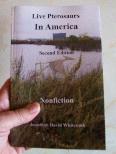I now refer to an Amazon.com book review that I wrote for Hunting Marfa Lights (book by James Bunnell, published by Lacey Publishing Company, December, 2009). For the complete review, see the Amazon page.
. . . Many eyewitness reports are included and examined. This includes about three of the reports in light of the possibility of night-mirages, which are demonstrated in pictures. And there are many pictures of the lights and the equipment and much else. This is a deep study.
. . . I did not expect Mr. Bunnell to have researched the ropen light of Papua New Guinea; that would have been extraordinary, beyond reasonable expectations. But I believe that most of the Marfa Lights are caused by animals related to the ropen (apparently a bioluminescent living pterosaur). I was delighted that much of the data in “Hunting Marfa Lights” supports the ropen-light interpretation (I expect he’ll be amused at my suggestion). Some natives in Papua New Guinea have reported something like the dripping of glowing material that falls from the large ropens as they glow during flight. The dynamic pulsating glow of ropens (also the brighter flashes and more than one brightness level) relates to some observations of Marfa Lights.
I did not expect the author to consider the revolutionary idea that the splitting of one Marfa Light into two (with a bright flash) was a ropen-partner turning on its bioluminescence while close to a glowing ropen. They would be coordinating a hunt, perhaps for the Big Brown Bat or for owls or other prey.
I did not expect him to consider that the reason Marfa Lights are rare (only a few event-nights per year in the Marfa area) are because flying bioluminescent creatures in Southwest Texas and Mexico cover a wide area. They search far and wide for easy prey at night, similar to other large predators that hunt on the ground.
I did not expect him to know about the many eyewitness testimonies of ropens in Papua New Guinea. But I was delighted with his thorough examination of much data, showing the difficulties in many other interpretations. It confirmed my belief in the ropen hypothesis, for no other hypothesis seems to match the detailed descriptions of some of these Marfa Lights.
Notwithstanding my opinions about Bunnell’s research and investigations, my last communication with him, in mid-2010, should be noted. At that time, the author of Hunting Marfa Lights found my hypothesis interesting (a number of bioluminescene flying predators), but he told me about several points that he felt did not fit it. I have since found explanations for his points, explanations that would allow for a bioluminescent-flying-predator interpretation. As of October 11, 2010, however, I have not given him those counter-suggestions.
A side note: Bioluminescence is more common with sea creatures than with land creatures, notwithstanding fire flies. But there is nothing unscientific about the possibility of large unclassified bioluminescent flying creatures.



 Did you know that living pterosaurs have been reported in North America, even in the United States? Read the many eyewitness sighting reports by purchasing a nonfiction book on
Did you know that living pterosaurs have been reported in North America, even in the United States? Read the many eyewitness sighting reports by purchasing a nonfiction book on